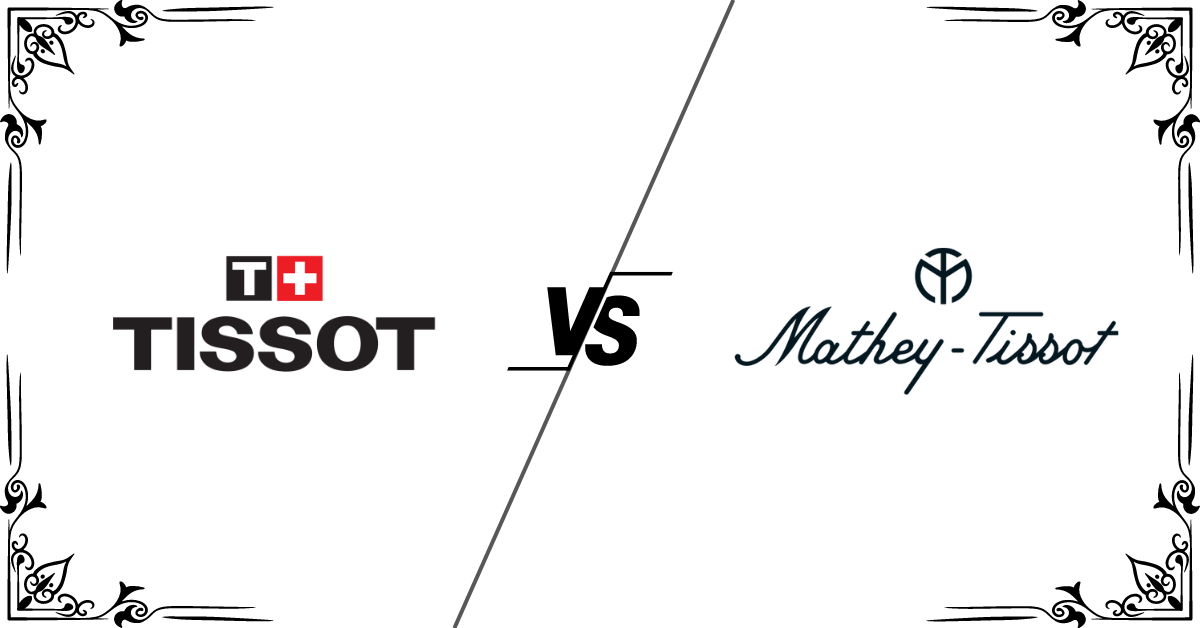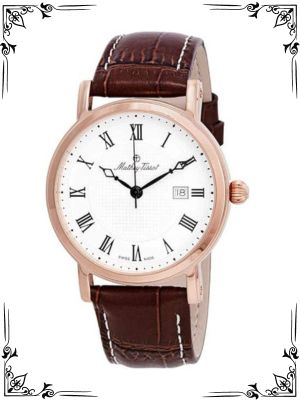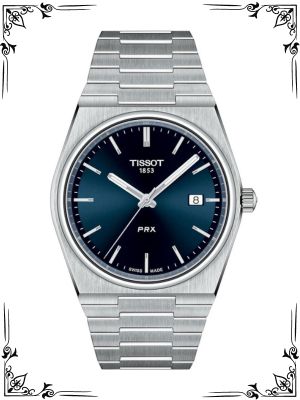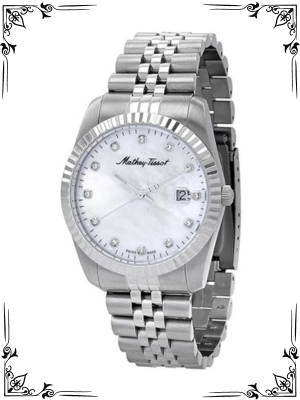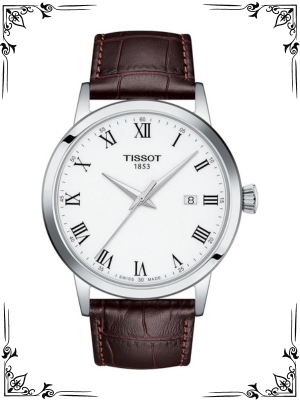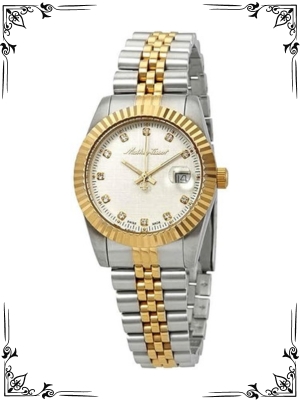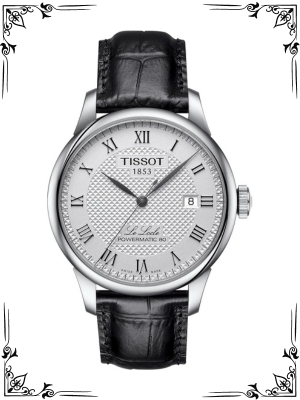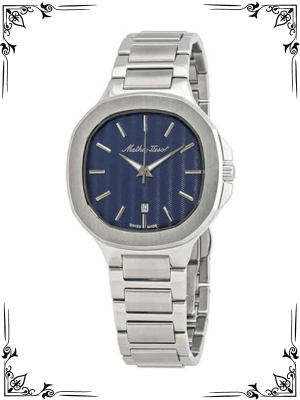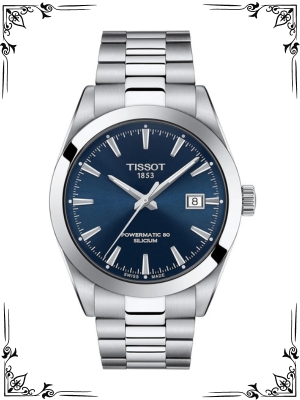Greetings, watch enthusiast! Are you considering a sophisticated Swiss timepiece but find yourself entangled between two alluring brands: Tissot and Mathey-Tissot? Both boast rich histories and undeniable Swiss heritage, but their paths have diverged over time.
Fret not, intrepid explorer! We’re about to embark on a detailed journey, dissecting the technical aspects, design philosophies, and brand identities of Tissot and Mathey-Tissot. By the end of this exploration, you’ll be well-equipped to choose the Swiss watch that perfectly complements your style and budget.
A Legacy of Innovation: Unveiling the Brand Histories
Tissot: Founded in 1853 by Charles-Félicien Tissot and his son Charles-Émile, Tissot has established itself as a titan in the Swiss watch industry. Renowned for its commitment to innovation and accessibility, Tissot boasts a rich heritage of pioneering technologies.
From the world’s first mass-produced pocket watch with an exposed balance spring in 1867 to the innovative T-Touch series featuring touch-screen functionality, Tissot has consistently pushed the boundaries of watchmaking while remaining relatively affordable.
Mathey-Tissot: Established in 1886 by Edmond Mathey-Tissot in Les Ponts-de-Martel, Mathey-Tissot shares a historical connection with Tissot through their founder’s surname. However, the two companies have operated independently for over a century.
Mathey-Tissot initially focused on pocket watches but transitioned to wristwatches in the early 20th century. Today, Mathey-Tissot positions itself as a manufacturer of prestige watches with a focus on classic and elegant designs.
Here’s a table summarizing the key historical aspects:
| Feature | Tissot | Mathey-Tissot |
|---|---|---|
| Year Founded | 1853 | 1886 |
| Founder(s) | Charles-Félicien Tissot & Charles-Émile Tissot | Edmond Mathey-Tissot |
| Brand Identity | Innovation, Accessibility | Prestige, Classic Designs |
Under the Hood: A Technical Breakdown
While both brands boast Swiss heritage, there might be subtle differences in their technical approaches:
Movement
Tissot: Primarily utilizes Swiss quartz movements (ETA or Ronda) for their timepieces. They also offer some models with automatic movements, often sourced from reliable Swiss manufacturers like ETA or Sellita. The specific movement type will vary depending on the model and price point.
Mathey-Tissot: No longer manufactures its own movements. They typically rely on customized mechanical and quartz movements sourced from other manufacturers. The specific movement details might not always be explicitly advertised for all Mathey-Tissot models.
Here’s a table summarizing the key movement aspects:
| Feature | Tissot | Mathey-Tissot |
|---|---|---|
| Movement Type | Primarily Swiss quartz (ETA, Ronda), some automatic (ETA, Sellita) | Customized mechanical & quartz (source varies) |
Materials and Construction
Tissot: Primarily utilizes 316L stainless steel for their watch cases. Some higher-end models might incorporate materials like titanium or PVD coating for a unique aesthetic. Tissot offers a variety of straps and bracelets, including leather, stainless steel, and rubber.
Mathey-Tissot: Also utilizes 316L stainless steel for the watch cases in most models. Some variations might offer precious metal options like gold plating for a more luxurious look. Mathey-Tissot typically utilizes leather straps for a classic and elegant aesthetic, although some models might offer other strap options.
Here’s a table summarizing the key materials and construction aspects:
| Feature | Tissot | Mathey-Tissot |
|---|---|---|
| Case Material | Primarily 316L stainless steel (some titanium, PVD) | Primarily 316L stainless steel (some precious metal options) |
| Strap/Bracelet Options | Leather, stainless steel, rubber | Primarily leather (some other options may be available) |
Functions and Features
Tissot: Offers a wider range of functionalities depending on the model. This could include features like chronographs, perpetual calendars, water resistance up to 300 meters (30 ATM), and touch-screen functionalities (T-Touch series).
Mathey-Tissot: Focuses on classic timekeeping features with an emphasis on elegance. This typically includes functions like date complications, moon phases, and water resistance suitable for everyday wear (often around 30 meters (3 ATM)). Advanced functionalities like chronographs or high water resistance are less common in Mathey-Tissot watches.
Here’s a table summarizing the key functions and features aspects:
| Feature | Tissot | Mathey-Tissot |
|---|---|---|
| Function Focus | Wider range (chronographs, perpetual calendars, high water resistance, touch-screen) | Classic timekeeping (date, moon phase, moderate water resistance) |
A Matter of Style: Design and Aesthetics
Tissot and Mathey-Tissot cater to distinct design sensibilities:
Dial Design
Tissot: Offers a diverse range of dial designs, from sporty chronographs with tachymeter scales to minimalist dress watches with clean aesthetics. Tissot embraces a variety of colors and finishes for their dials, catering to different tastes.
Mathey-Tissot: Prioritizes classic and elegant aesthetics. Their dials often feature Roman numerals, intricate hands, and a focus on clean legibility. Color options for dials might be more limited compared to Tissot.
Case and Bracelet
Tissot: Offers a variety of case sizes and styles. Their watches can range from sporty and bold with thicker cases to sleek and sophisticated for dressier occasions. Tissot offers a selection of bracelets and straps to complement different styles.
Mathey-Tissot: Leans towards thinner and more elegant cases. Their designs prioritize classic aesthetics over bold statements. Leather straps are the most common choice for Mathey-Tissot watches, although some models might offer alternative options.
Brand Image
Tissot: Projects a more modern and innovative image. They are known for their sporty and functional timepieces, while also offering elegant options. Tissot caters to a wider audience with a focus on accessibility in terms of price point.
Mathey-Tissot: Cultivates an image of prestige and heritage. Their focus on classic designs and elegant details positions them as a brand for those who appreciate traditional watchmaking aesthetics. Mathey-Tissot watches might have a slightly higher price point compared to some Tissot models.
Here’s a table summarizing the key design and aesthetic
| Feature | Tissot | Mathey-Tissot |
|---|---|---|
| Dial Design | Diverse (sporty to minimalist, various colors/finishes) | Classic and Elegant (Roman numerals, intricate hands) |
| Case and Bracelet | Variety of sizes and styles (sporty to dressy) | Thinner, Elegant Cases (primarily leather straps) |
| Brand Image | Modern, Innovative, Sporty & Functional | Prestige, Heritage, Classic Designs |
Popular Models and Series of Tissot
Tissot Le Locle: Named after Tissot’s hometown, the Le Locle series is known for its classic, elegant design and reliable automatic movements. It’s a favorite among those who appreciate timeless style and Swiss craftsmanship.
Tissot PRX: The PRX series has gained popularity for its sleek, modern design and integrated bracelet. The PRX 40 205 models, in particular, have been praised for their retro-inspired looks and affordability.
Tissot T-Touch: The T-Touch series is a pioneer in multifunctional watches with touch-sensitive sapphire crystals. Features like altimeters, compasses, and barometers make it popular among tech-savvy and outdoor enthusiasts.
Tissot Seastar: The Seastar series is Tissot’s answer to the diving watch market. With robust water resistance, luminous markers, and reliable movements, it’s popular among those who need a durable and stylish dive watch.
Tissot Heritage: The Heritage series pays homage to Tissot’s rich history, featuring vintage-inspired designs with modern technology. Models like the Heritage Visodate are particularly loved for their retro aesthetics and automatic movements.
Popular Models and Series of Mathey-Tissot
Mathey-Tissot Edmond: The Edmond series is celebrated for its classic and sophisticated designs. These watches often feature high-quality automatic movements and elegant dials, making them a favorite for formal occasions.
Mathey-Tissot Hiker: The Hiker series is popular among those who appreciate robust, adventure-ready watches. With features like high water resistance and durable construction, it’s designed for outdoor enthusiasts.
Mathey-Tissot Retro: The Retro series captures the essence of vintage watchmaking with classic designs and traditional craftsmanship. These models are favored by those who enjoy a nostalgic, old-world charm in their timepieces.
Mathey-Tissot Type XX: Inspired by aviation, the Type XX series features chronographs with a distinctive military-style design. These watches are popular among aviation enthusiasts and those who appreciate historical timepieces.
Mathey-Tissot Classic: The Classic series offers timeless designs with a focus on elegance and simplicity. These watches are versatile and suitable for both everyday wear and special occasions, appealing to those who prefer understated sophistication.
The Final Lap: Choosing Your Champion
With a comprehensive understanding of Tissot and Mathey-Tissot, you’re well-equipped to make an informed decision. Here’s a quick guide to help you pick your perfect Swiss watch companion:
Choose Tissot if:
- You prioritize modern and innovative features like chronographs, high water resistance, or touch-screen functionalities (T-Touch series).
- You appreciate a wider range of styles from sporty to minimalist, with a variety of dial colors and finishes.
- Accessibility in terms of price point is important to you.
- You value a brand that constantly pushes the boundaries of watchmaking.
Choose Mathey-Tissot if:
- You’re a fan of classic and elegant aesthetics with a focus on timeless design.
- You appreciate the prestige and heritage embodied in a Swiss watch brand.
- Leather straps and traditional timekeeping features like date complications or moon phases resonate with you.
- You’re willing to invest in a watch with a potentially slightly higher price point compared to some Tissot models.
Conclusion
Tissot and Mathey-Tissot, though sharing a historical connection, offer distinct experiences:
- Innovation vs. Tradition: Tissot prioritizes cutting-edge technology and functionality, while Mathey-Tissot focuses on classic design and elegance.
- Versatility vs. Refinement: Tissot offers a wider range of styles for diverse tastes, while Mathey-Tissot cultivates a refined and sophisticated aesthetic.
- Accessibility vs. Prestige: Tissot caters to a broader audience with a focus on affordability, while Mathey-Tissot positions itself as a prestige brand with a slightly higher price point (depending on the model).
Ultimately, the perfect choice boils down to your personal preferences and watch collecting goals. Do you seek a feature-packed timepiece for an active lifestyle or a timeless companion that exudes classic elegance? With the knowledge you’ve gained, you’re well on your way to selecting the ideal Swiss watch that complements your style and personality. Happy watch hunting!
FAQs
How do the histories of Tissot and Mathey-Tissot compare?
Tissot was founded in 1853 in Le Locle, Switzerland, and quickly gained a reputation for innovation and quality. Mathey-Tissot, established in 1886 in Les Ponts-de-Martel, Switzerland, also boasts a long history, initially gaining prominence for its high-quality pocket watches and military timepieces.
While both brands share Swiss heritage, Tissot is better known globally due to its extensive marketing and broader product range.
What are the main differences in their watch collections?
Tissot offers a wide variety of collections, including sporty, classic, and innovative watches such as the T-Touch series. Their lineup caters to diverse tastes and includes both mechanical and quartz movements.
Mathey-Tissot, on the other hand, focuses more on classic and elegant designs, often featuring vintage-inspired aesthetics and traditional craftsmanship. Their collections are typically smaller but emphasize high-quality finishes and timeless styles.
How do Tissot and Mathey-Tissot compare in terms of pricing?
Tissot watches generally range from $200 to $2,000, offering a wide spectrum of options from entry-level to mid-range luxury. Mathey-Tissot watches are typically priced from $300 to $1,500, placing them in a similar range but often focusing on more classic and dressy timepieces.
Both brands offer good value for money, but Tissot provides more variety at different price points.
Which brand offers more technological innovations?
Tissot is known for its technological innovations, such as the T-Touch series, which includes touch-sensitive sapphire crystals and multiple functions like altimeters and compasses. Tissot also leads in integrating modern materials and smart technology.
Mathey-Tissot tends to focus on traditional watchmaking techniques and classic designs, with less emphasis on modern technology and multifunctional features.
How do Tissot and Mathey-Tissot compare in terms of brand recognition and market presence?
Tissot has a significant global presence and is widely recognized due to its extensive marketing efforts, sponsorships in sports, and broad distribution network. This makes Tissot a household name in many parts of the world.
Mathey-Tissot has a more niche following, known among watch enthusiasts who appreciate its classic designs and historical significance. While less recognized than Tissot, Mathey-Tissot is respected for its craftsmanship and quality.

